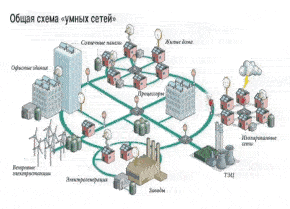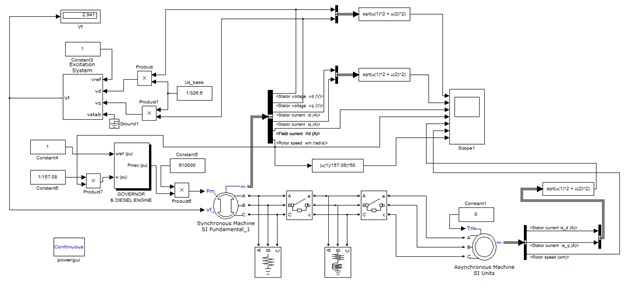Abstract
Content
- Introduction
- 1. Relevance of the topic
- 2. The purpose and objectives of the study
- 3. Local MicroGrid system
- 4. The implementation of the autonomous intelligent system in the Simulink environment
- Conclusion
- References
Introduction
The growth of the world's population and the development of industry, the increase in electricity consumption per capita, energy–intensive industrial production and, at the same time, limited sources of energy – this is one of the main problems facing modern energy. The world has developed two concepts to overcome this problem – the development of Smart Grids and Micro Grids. Each of them is good and separate, but in no case can they be opposed, since the joint use of two approaches allows to achieve a synergistic effect. What does each of the concepts represent?
Smart Grid – is also the concept of smart / intelligent energy
. She is credited with the ability to heal itself after failures,
resistance to physical and computer attacks, ensuring the necessary quality characteristics in the supply of electricity, interconnection
and synchronism of work of various nodes of the system, the use of modern high technologies. The implementation of this concept implies the
use of innovative technologies in the electric power industry, the expansion of its scope to new industries, such as motor vehicles with
electric motors, the creation of backup channels for the delivery of electricity to consumers, the commissioning of modern and diverse sources
of energy production.
Micro Grid – the concept of small distributed energy. It assumes the creation in certain territories of separate power grid structures that have their own energy sources and are able to take on the task of meeting the demand of consumers at maximum peak loads, when the central network cannot provide it. A separate feature of this trend is the use of renewable energy sources, which every year, due to the deteriorating environmental situation, are becoming more and more relevant.
1. Relevance of the topic
The most important technical problem of creating such power systems is to maintain the specified values of voltage and frequency of current for each consumer and uninterrupted power supply to these consumers. The solution of the problem is connected with ensuring the power balance: the generation power at each time point should be equal to the sum of the powers of all consumers, the power losses in networks and equipment, the power developed by the electricity storage devices in the mode of electricity consumption. At the same time, it is important to take into account that the drives can also be used in the mode of supplying electricity to the network, and then the sum of the generation capacities and the accumulators in the output mode should be equal to the sum of the powers of the consumers and the power losses. Ensuring the described balance of power is provided in microgrid by the fact that all consumers, all generating equipment and all electric power drives exchange information about themselves and their mode of operation with each other and, realizing the automatic algorithm of optimal control, set the value of their power.
The second problem arising in the design and creation of local energy systems such as microgrids is to ensure the efficiency of such a system and the choice of the minimum necessary equipment that is necessary to create a power system. The option of creating a local power system in a number of cases may well compete with the construction or expansion of the network infrastructure. For this, the cost of building the local power grid should be optimized.
2. The purpose and objectives of the study
The purpose and objectives of the research: to simulate an autonomous energy system in which it is necessary to investigate the generator idling, short circuit at idling, excitation regulators and generator speed, connecting SG to the network, determine the magnitude of the shock currents during a short circuit on the generator leads, voltage landing at connecting static load. It is also necessary to investigate the mode of parallel operation of two SG on the load
3. Local MicroGrid system
Microgrid refers to a group of interconnected customer loads and distributed energy resources within well-defined boundaries, which acts as a single managed object that can be connected and disconnected from the network.
The local MicroGrid system (microgrid
),as a rule, includes one or several distribution substations and energy storage complexes,
which allows it both to function autonomously and to be connected with the external power system. Microgrid systems can have various sizes:
from small networks for providing several residential buildings to large power supply systems of enterprises and business centers. Usually,
microgrids are built in a short period of time to meet local electricity needs and do not imply the transmission of electricity over long
distances.
There are three types of energy microgrids:
The network of the first type supplies energy to one building, ensuring its independence from a centralized AC network. But the second
type is most often encountered – campus networks providing energy to a complex of buildings in a certain area. An internal distribution
network and an internal source of energy are being created on this territory. The campus network, like the network of the first type, can
operate independently of the centralized grid. The third type of network operates according to the Internet method using the distribution network topology.
As the reliability and stability of networks increases, the integration of distributed generating capacities and energy storage systems
increases, the distribution network begins to turn into a set of interconnected microgrids. Such networks can operate completely independently,
and in emergency cases connect to external networks [1].
.
Advantages of the MicroGrid network:
- Easy integration of renewable energy sources
- Self–repairing energy supply system
- Uninterrupted supply of electricity
- Low cost of network deployment
- Improving the efficiency of the grid due to the return of users of energy into the network (Feed–in–Tariff)
The main components for building a microgrid:
- gas or diesel generators;
- wind farms;
- solar stations;
- hydraulic stations;
- other renewable sources, such as geothermal power plants [2];
- conclusions to the distribution network;
- connection to the backbone network or local network (optional);
Energy storage:
- mechanical drives and stabilizers (short-term) [3];
- rechargeable batteries (long-term);
Controlled consumers:
- industrial (enterprises, factories, etc.);
- commercial (lighting, heating, cooling offices, shops, etc.);
- private (lighting, heating, cooling, pumps for pools, small receivers and devices, etc.).
In many developed countries that have proclaimed a course on renewable energy, citizens are promised to buy back the excess electricity
generated by their personal energy sources, such as solar panels or wind generators. However, in fact, to realize this opportunity is not as
easy as it seems. Often, companies that serve such networks, offer not the most profitable tariff plan, or hide some pitfalls
.
Their position is easily explained. Electric companies aimed at making a profit are interested in a stable volume of energy supply. In conditions when the end user can choose a supplier, operators are concerned about the quality and stability of the energy received from small producers, the slightest deviation from the standards threatens them with loss of income. However, thanks to government regulatory measures, the number of small-scale energy producers is growing. However, in addition to administrative pressure, there are other high-tech methods to increase the attractiveness of small supplies.
The problem of optimizing the connection of small energy producers to a common network is the problem of the lack of efficient technologies.
Working autonomously in the energy island
mode, such micro networks with a capacity of less than 10 MW are capable of reliably supplying power
to office centers, industrial facilities, residential neighborhoods, university campuses and military bases.
Moreover, microgrids are able to completely dispense with connecting to a common power supply system, easily integrating local renewable energy sources, such as solar panels and wind turbines, to smooth out peak loads. Long power lines – the main source of energy loss. Micro-network technologies are focused on using local renewable sources, as a result there is no need to transport energy over long distances, which reduces losses. The generation of electricity is usually accompanied by the release of a significant amount of heat, which can be used right there on the spot for heating and cooling buildings. Such a combined production will increase the efficiency of energy sources from the existing 35% to 85%, simultaneously reducing the level of carbon dioxide emissions into the atmosphere.
Microgrids do an excellent job with improving the reliability of power supply by quickly switching consumers between the total power grid and local energy sources in the event of overloads and voltage surges.
It is possible that in the future the main advantage of microgrid technologies will be their easy and fast adaptation to consumers as opposed to centralized power supply systems. Construction of large energy facilities and extensive distribution networks requires a long time. Microgrids are able to supply energy much faster, focusing on low-power local sources.
Currently, there are two ways to develop micro network technologies. The main method recognized by the majority implies constant remote computer monitoring of all sections of the microgrid. Its disadvantages are excessive reliance on computing capacities and communication channels, which can reduce the reliability of the system as a whole.
An alternative approach is to automatically change the significant parameters of the microgrid based on changes in the frequency of electrical oscillations in it. This technology is called Consortium for Electric Reliability Technology Solutions (CERTS).
As an example in Figure 1 a microgrid network is presented that includes a set of generating sources and a set of consumers. Generating
facilities are represented by a combination of traditional sources operating on diesel (diesel generators) or gas (gas-piston engines),
small hydro power plants and renewable energy sources (mainly wind turbines and solar stations). Any combination of these sources is possible,
and if the main reason for using renewable energy is a purely economic effect (subsidies, guaranteed tariff, etc.) or a reduction in primary
fuel consumption, the type of electricity source does not matter much. It is worth noting that the replacement of the traditional source of
green
will also have a positive impact on the environmental aspect. If it is important for the end user to reduce harmful emissions from
raditional sources and to improve the standard of living, then for owners of generation, the use of renewable energy also reduces the taxation
for harmful emissions. In some countries, this factor has become decisive for the application of renewable energy sources in local networks.

Figure 1 – MicroGrid Network
(Animation: 7 frames, 7 cycles of repetition, 196 kilobytes)
The main negative factors of the use of renewable energy sources and their impact on the local network are rooted in the very principle of energy production, since it depends on climatic conditions. For example, a purely island mode of operation is excluded: RES is turned off by the network operator when an island mode appears, in which only alternative sources will participate or participate. The second important factor is high variability in the production of energy itself. You can also note the weak predictability of the volume of generated energy.
For example, if we consider the work of the solar and wind stations, then in both cases climatic conditions and their changes throughout the year play a special role. In connection with this, it is impossible to produce high-quality electric power in island networks isolated from the main networks without parallel connection of traditional sources.
As part of the use of microgrids, there is great potential in remote regions, at industrial enterprises (mining, processing), which either do not receive energy from the main networks or experience difficulties with the quality of the energy supplied (due to voltage and frequency fluctuations, power cuts, etc.).
4. The implementation of the autonomous intelligent system in the Simulink environment
Simulink – a graphical simulation environment that enables using the block diagram in the form of directed graphs, build a dynamic model, including discrete, continuous and hybrid, nonlinear and discontinuous systems [4].
Interactive environment the Simulink, allows the use of ready–made library of blocks to model the electric power, mechanical and hydraulic systems, as well as to apply the developed model–based approach in the development of control systems, means of digital communications and real-time devices.
Additional expansion packs Simulink can solve the whole range of tasks from concept models to test, test, code generation and hardware implementation. Simulink is integrated with MATLAB environment that will allow use of built-in mathematical algorithms, powerful data processing tools and scientific graphics.
Simulink Library Browser (Myramistin view Simulink Library) contains a block library of the most commonly used for modeling systems.
In this library include:
- blocks of continuous and discrete dynamics, such as Integrator (Integrator) and Unit Delay (Delay Link);
- algorithmic blocks, such as Sum (adder), Product (product), Lookup Table (Reference Table);
- building blocks, such as Mux (multiplexer), Switch (switch), Bus Selector (selector tires).
You can perform a simulation of the dynamic properties of the system and see the results as soon as the simulation is started. In order to ensure a predetermined speed and accuracy of simulation, the Simulink ODE solvers provides fixed and variable pitch, a graphical debugger, and time estimation routine performing certain functions of the model.
Solvers – are numerical integration algorithms that compute the system dynamics over a certain period of time, using the information contained in the model. Simulink provides solvers to simulate a wide range of system types, including continuous–time systems (analog), discrete-time (digital), hybrid (mixed signal) and systems with different sampling periods of any size. With solvers in Simulink can perform a simulation of stiff systems and systems with discontinuities. You can set the simulation options, including the type and properties of the solver, the start and end of the simulation and perform the download or save simulation data. You can also customize the optimization and diagnostic information. Along with the model, you can save different optional combinations.
Key features of Simulink
- an interactive graphical environment to build a block diagram;
- expandable library of ready-made blocks;
- handy tools for building multi-tiered hierarchical model;
- navigation and settings of complex models – Model Explorer;
- integration tools ready C / C ++, FORTRAN, ADA and MATLAB–algorithms to model the interaction with external programs for modeling;
- modern means of solving differential equations for continuous, discrete, linear and non-linear objects (including hysteresis and breaks);
- simulation of non-stationary systems using solvers with variable and constant pitch or managed by batch from MATLAB simulations;
- handy interactive visualization of output signals, configuration tools and tasks of input actions;
- debugging and analysis models;
- full integration with the MATLAB, including numerical methods, visualization, data analysis and graphical interfaces.
Figure 2 shows the autonomous system diagram. Pre-powered load generator. This scheme was built in Simulink and taken as a basis for further consideration of the goal [5].

Figure 2 – Model of the start of the engine with the pre-included nominal load
Conclusions
The results of the thesis are as follows:
- With the help of microgrid systems analysis, the main problems of these systems were identified, their advantages, typology and components were considered. Examples show how microgrid systems work.
- To simulate and explore such modes as:
- Simulate the mode of parallel operation of two SG.
References
- Черных И. В. Моделирование электротехнических устройств в MATLAB. SimPowerSystems и Simulink. – М.: ДМК Пресс, 2007. – 288с.
- Магомедов А. М Нетрадиционные возобновляемые источники энергии, Юпитер, 1996 год, 245 стр.
- Ульянов С. А., Электромагнитные переходные процессы в электрических системах, Энергия, 1964 год, 519 стр.
- Электронный источник MATLAB и Simulink центр компетенций компании Mathworks: http://matlab.ru.
- Справочник по электроснабжению и электрооборудованию: в 2 т. Под общ. ред. А. А. Федорова. Т 2 Электрооборудование. – М.: Энергоатомиздат, 1987. – 592 с.
- Крючков, И. П. Расчет коротких замыканий и выбор электрооборудования: учеб. пособие для студ. учеб. заведений / И. П. Крючков, Б. Н. Неклепаев, В. А. Старшинов и др.; под ред. И. П. Крючкова и В. А. Старшинова. – 2-е изд., стер. – М.: Издательский центр
Академия
, 2006 – 416 с. - Электронный источник: http://lektsii.org.
